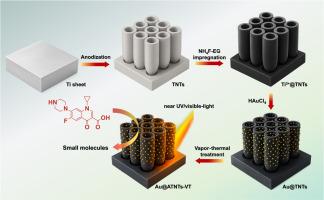In-situ Ti3+-mediated loading of Au nanoparticles on TiO2 nanotube arrays for enhanced near UV/visible-light photocatalytic degradation of ciprofloxacin
IF 6.3
3区 工程技术
Q1 ENGINEERING, CHEMICAL
Journal of the Taiwan Institute of Chemical Engineers
Pub Date : 2025-09-20
DOI:10.1016/j.jtice.2025.106422
引用次数: 0
Abstract
Background
Fluoroquinolone antibiotics such as ciprofloxacin (CIP) are highly persistent in the environment and resistant to conventional wastewater treatment processes, necessitating the development of efficient visible-light-driven photocatalysts. However, wide-bandgap TiO2 nanotube arrays (TNTs) exhibit limited visible-light absorption and insufficient charge separation efficiency.
Methods
Amorphous TNTs fabricated via anodic oxidation were impregnated in an NH4F-containing ethylene glycol solution, inducing a disproportionation reaction at the Ti/TiO2 interface to generate Ti3+ species. These Ti3+ species acted as reductants to in-situ reduce Au3+ to metallic Au nanoparticles (Au NPs, ∼5.3 nm), uniformly distributed on the nanotube surfaces. Subsequent vapor-thermal treatment transformed the amorphous TNTs into the anatase phase while effectively suppressing Au NPs aggregation, yielding the composite Au@ATNTs-VT.
Significant Findings
The resulting Au@ATNTs-VT exhibited enhanced visible-light absorption and improved separation of photogenerated charge carriers. Photocatalytic degradation tests revealed 87% CIP removal under near UV/visible-light irradiation, significantly surpassing unmodified TiO2 nanotubes. The catalyst also maintained over 85% degradation efficiency after five consecutive cycles, demonstrating excellent stability and reusability. This Ti3+-induced in-situ Au loading strategy offers a promising route for designing high-performance TiO2-based photocatalysts for antibiotic wastewater treatment.

TiO2纳米管阵列Ti3+原位负载金纳米粒子增强近紫外/可见光光催化降解环丙沙星
环丙沙星(CIP)等氟喹诺酮类抗生素在环境中具有高度持久性,并且对传统的废水处理工艺具有抗性,因此需要开发高效的可见光驱动光催化剂。然而,宽禁带TiO2纳米管阵列(TNTs)的可见光吸收有限,电荷分离效率不足。方法将阳极氧化法制备的非晶态tnt浸渍在含nh4f的乙二醇溶液中,在Ti/TiO2界面处诱导歧化反应生成Ti3+。这些Ti3+物种作为还原剂将Au3+原位还原为金属金纳米粒子(Au NPs,约5.3 nm),均匀分布在纳米管表面。随后的气相热处理将无定形tnt转化为锐钛矿相,同时有效抑制Au NPs聚集,得到复合材料Au@ATNTs-VT.Significant研究结果Au@ATNTs-VT显示出增强的可见光吸收和光生电荷载流子的分离。光催化降解测试显示,在近紫外/可见光照射下,CIP去除率为87%,显著优于未修饰的TiO2纳米管。该催化剂在连续5次循环后仍保持85%以上的降解效率,具有良好的稳定性和可重复使用性。这种Ti3+诱导的原位Au负载策略为设计用于抗生素废水处理的高性能tio2光催化剂提供了一条有前途的途径。
本文章由计算机程序翻译,如有差异,请以英文原文为准。
求助全文
约1分钟内获得全文
求助全文
来源期刊
CiteScore
9.10
自引率
14.00%
发文量
362
审稿时长
35 days
期刊介绍:
Journal of the Taiwan Institute of Chemical Engineers (formerly known as Journal of the Chinese Institute of Chemical Engineers) publishes original works, from fundamental principles to practical applications, in the broad field of chemical engineering with special focus on three aspects: Chemical and Biomolecular Science and Technology, Energy and Environmental Science and Technology, and Materials Science and Technology. Authors should choose for their manuscript an appropriate aspect section and a few related classifications when submitting to the journal online.

 求助内容:
求助内容: 应助结果提醒方式:
应助结果提醒方式:


